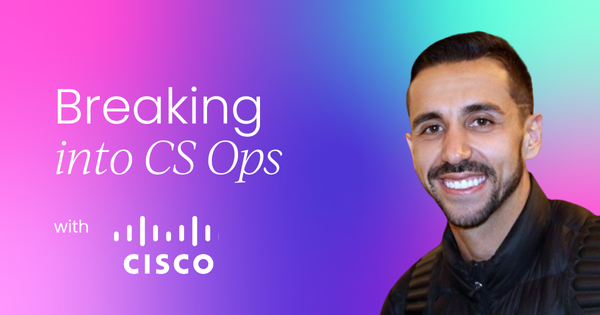It’s not easy starting out in a new role, especially if that role is already a subsect of a relatively new field like customer success. Customer success operations (CS Ops) is an emerging area that plays a crucial role in helping organizations scale their customer success efforts.
For those looking to transition into this niche, understanding the unique challenges and opportunities it presents is critical.
I’m Roger Mendez, the Global Leader of Strategic Programs in Customer Success and Acceleration at Cisco.
In this article, I draw on my experience of over eight years to provide insights on how to break into CS Ops, what to expect, and how to thrive in what I believe to be the new innovative frontier of customer success. I’m specifically going to discuss:
- The mental shift from moving into CS Ops from a CSM role
- The key skills needed of a CS Ops Manager
- The unique opportunities of CS Ops
- The challenges of CS Ops
- A day in the life of a CS Ops Manager
Roger spoke more about this very topic at Customer Success Festival San Francisco on September 4-5, 2024. You can watch it OnDemand with a CSC membership plan.
Moving into customer success operations from a general Customer Success Manager role
One thing I love about customer success is cultivating relationships and maintaining a relationship standard across the organization.
In my early days as a Customer Success Manager (CSM), one of my favorite customers was Nationwide. During a visit to Ohio, a key stakeholder confided in me about a decision they were considering between Cisco and a competitor. They valued my opinion and saw me not just as a Cisco employee, but as a trusted advocate who could consult with them on advantageous decisions.
Going from a broad CSM role into customer success operations definitely requires a significant mental shift. In CS Ops, the dynamics change because your company becomes your customer.
For example, at Cisco, I work with various key stakeholders and different groups within the organization. We have teams focused on building specific actions and deliverables for customer success, and teams dedicated to enabling field teams with the right tools and resources to accelerate their customers' time to value.

Transitioning to CS Ops means managing multiple groups and parts of the organization. It's not just about working with a few stakeholders anymore; it's about ensuring the entire organization moves forward effectively.
A philosophy I follow is that it's okay to fail, but “fail fast and let others know where you're going so they can help you get back on track.” In CS Ops, our role is to ensure every team across the company feels supported and successful.
This transition has been exciting but challenging. Instead of focusing solely on success plans and ROI, the focus is now on large-scale implementation across all organizational segments, including enterprise, commercial, EMEA, and APJ. Scaling at an accelerated rate requires coordination and effective communication across all these segments.
Skills needed to become a Customer Success Operations Manager
If you're interested in transitioning into a CS Ops role, it's important to understand the unique blend of skills and mindset required.
Here are some pathways and initial steps to consider:
Embrace innovation and creativity
CS Ops is a new and innovative field. Organizations recognize the need for a CS Ops foundation to create programs and achieve operational excellence.
If you're excited about changing the direction of your company and have a creative mindset, CS Ops could be a great fit for you. Unlike roles that rely on established formats and processes, CS Ops requires innovative thinking and a willingness to develop new strategies.

Leverage data insights
One of the key aspects of CS Ops is working with extensive data.
As a CSM, you're on the front line, strategically and tactically working with customers to address their needs. In CS Ops, you'll be looking at data from a broader perspective. You'll analyze customer spending, engagement, and progress in their customer success journey. This involves identifying segments of customers who might not be seeing the full value of customer success and creating programs to address these gaps.
If you love working with data, CS Ops will provide ample opportunities to dive into analytics and derive actionable insights.
Build relationships with key stakeholders
A great jumping-off point that I recommend to anyone is to start building relationships with key stakeholders in your customer success team. Try to understand what your company's CSMs do, including their focus on expansion opportunities, adoption, and renewals, etc. Your objective is to engage with these various stakeholders to identify what's relevant and important to them.
Establishing a strong network within your company will be crucial as you transition into CS Ops.
Develop a framework
Establishing a framework for CS Ops is critical. I use the acronym “V.A.L.U.E.” to guide this process:
- Validate: Validate your company's initiatives and goals.
- Awareness: Create awareness of what you want to achieve within CS Ops.
- Learning: Understand the resources available to excel in your role.
- Utilization: Measure the utilization of tools and resources within the company.
- Embed: Fully immerse yourself in CS Ops to ensure your impact on the business is felt.
Get curious and involved
If this hasn't come across in this article, I'll reaffirm my stance: start getting curious about CS Ops and get involved in relevant programs wherever you can. Breaking into CS Ops requires a combination of innovative thinking, data analysis skills, strong relationships with stakeholders, and a strategic framework.
- Understand the different aspects of customer success and how they intersect with operations
- Immerse yourself in customer success
- Commit yourself to continual learning
By following these steps, you'll be well on your way to a fulfilling career in CS Ops.
The unique opportunities of customer success operations
Staying mindful and present
One of the opportunities in CS Ops is staying mindful in the current moment. When you're helping customers accelerate their use of technology, feedback becomes essential. Customers often express what's working well and what needs improvement.
In CS Ops, however, the focus shifts from immediate customer feedback to evaluating the effectiveness of actions toward organizational values and customer success goals. This shift helps you stay present and pivot as needed, ensuring alignment with the overall business strategy.
Building strategic foundations
At Cisco, we create strategic foundational pillars to ensure that any new process or program aligns with our core values and customer success objectives.
Whether it’s improving the renewal process or enhancing the activation process, we ask ourselves how these actions align with our foundational pillars. This alignment helps maintain consistency, accountability, and a clear focus on our long-term goals.
Innovating customer experience
Another exciting aspect of CS Ops is the opportunity to innovate customer experiences. For example, Cisco has developed a self-serve portal where customers can log in and track their customer success journey.
This not only provides transparency but also empowers customers by giving them visibility into their progress. Being part of such innovative initiatives is incredibly rewarding and positions us as game-changers in the industry.

The challenges of customer success operations
Building out structure
A significant challenge in CS Ops is establishing a robust structure. Measuring customer success and developing foundational pieces can be complex. It's essential to track various aspects of customer success and involve multiple teams, including those responsible for digital assets and customer journey mapping.
Depending on customer segmentation and spending, the customer success experience needs to be tailored, adding to the complexity.
Managing multiple priorities
CS Ops involves working with numerous key stakeholders across the organization. Each stakeholder may have different priorities and metrics. Ensuring alignment while addressing these diverse priorities can be challenging.
Unlike traditional CSM roles, which focus on specific areas such as customer sentiment, product usage, and retention, CS Ops might involve juggling 50 different priorities simultaneously. This requires careful management and a clear understanding of each stakeholder's goals.
Scaling effective processes
Scaling effective processes across the organization is another challenge. If a process works well in one area, replicating it across other regions, product lines, or customer segments requires meticulous planning and execution. Ensuring that these processes align with the company's overall strategy and foundational pillars is crucial for successful scaling.
CS Ops offers unique opportunities for innovation, strategic alignment, and customer empowerment. However, it also presents challenges in building structure, managing multiple priorities, and scaling processes.
Staying mindful, focusing on strategic foundations, and embracing innovation means professionals in CS Ops can navigate these challenges and drive significant value for their organizations.

A day in the life of a Customer Success Operations Manager
In a CS Ops role, no two days are the same, which keeps the job exciting and dynamic. Unlike a traditional CSM role, where you might have a more predictable routine, CS Ops involves a variety of tasks that change based on the business's needs.
For example, one day I might be hosting office hours for hundreds of CSMs, discussing their top priorities and challenges. The next day, I could be building a dashboard to analyze customer insights and user behavior with our products.
Another day might focus on accelerating the customer journey from purchase to 100 days of product usage. I could also be working on a campaign for upcoming renewals. The diversity of tasks is one of the reasons I love my job.
At Cisco, my role centers around strategic programs and top initiatives, which can change quarterly. In one quarter, I might be working on new product innovation, and in the next, I could be integrating acquisitions. This variability requires adaptability and a strategic mindset.
An essential part of my role involves being a brand advocate for Cisco. For instance, I had the opportunity to visit a top customer in New York City with our VP of Customer Success. During this visit, I not only represented Cisco but also took customer feedback to drive improvements. This dual role of advocating for the customer and influencing change within Cisco makes the job fulfilling.
One of the best pieces of advice I received was to maintain a "beginner's mind." This means approaching each task as if you're seeing it for the first time, which fosters creativity and innovation. Even though you might have prior experience, looking at things with fresh eyes can lead to significant improvements and new ideas.
CS Ops at Cisco encourages creativity and innovation. I've had opportunities to pitch ideas directly to senior executives, who are eager to hear new perspectives. They don't just want you to do the work; they want to hear your ideas and see how you can implement change. This level of empowerment is exciting and makes the role an adventure.
Customer success operations in a nutshell
CS Ops is far from typical. It's varied, dynamic, and filled with opportunities to innovate and influence change. The ability to work on different strategic initiatives, engage directly with customers, and drive improvements within the organization makes it an exciting and rewarding career.
By approaching each task with a beginner's mindset and a creative spirit, you can thrive in the ever-evolving field of customer success operations.
You can watch Roger's keynote, in full and OnDemand, along with hundreds of other sessions, with a CSC membership plan.



 Follow us on LinkedIn
Follow us on LinkedIn




